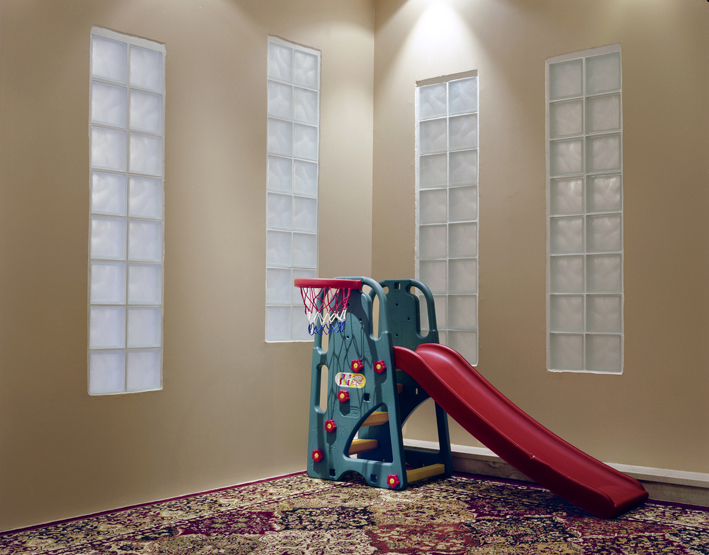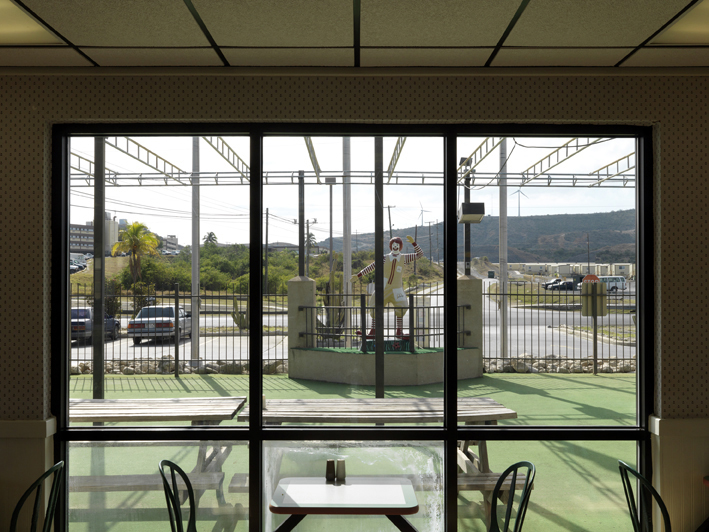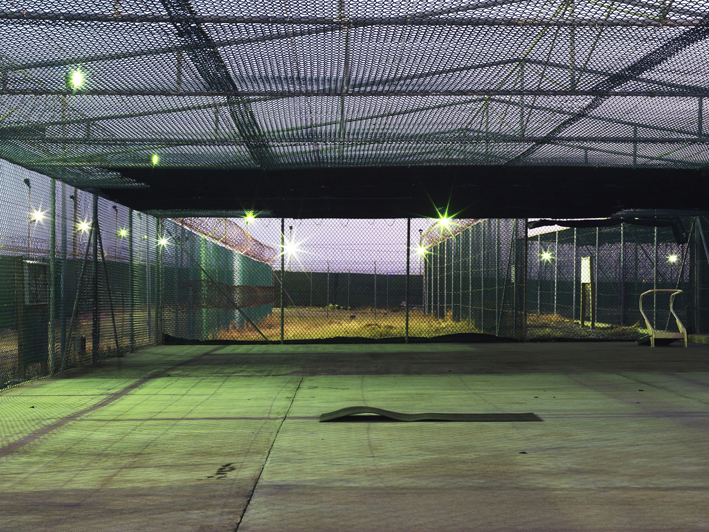
Torture works, terrorists are vanquished in the end, and the good guys usually come out on top. At least this is the narrative that recent Golden Globe winners “Homeland” and “Zero Dark Thirty” might have us believe. Of course, real life is far murkier. Award-winning British photographer Edmund Clark has chosen to examine the “war on terror” from a different angle, an angle from which there are no good or bad guys to be seen. Where there are, in fact, no people at all, just the spaces in which they live.
In 2008, Edmund Clark began photographing the homes of British ex-detainees who had been released from Guantanamo Bay. A year later, he travelled to Guantanamo itself to spend nine days—half at the prison camp and half on the naval base—photographing the living spaces of both inmates and U.S. military personnel. “I was fortunate in that I was there at end of April/early May, 2009 and Obama had just come into power, so there was a climate of greater transparency and relative openness,” he said.
The result is a collection of stark, unpeopled photographs that represent three ideas of home. An isolation cell in an apple-green palette with a single stool and an open metal gate photographed up close has a certain Caribbean beauty to it, until you realize what you are looking at. A force-feeding chair can at first glance look like something a dentist might use. There is an image of the fence dividing the Guantanamo base from the rest of Cuba, which shows a line of festive-looking lights strung across the inky darkness. In another, a child’s red plastic slide stands in the corner of an empty room, the floor covered in a MiddleEastern-style carpet.
Clark’s “Guantanamo: If The Light Goes Out” collection has been published as a book, and selections of those photos have been exhibited in the UK and New York. I met Edmund Clark in New York to talk about what drew him to capture these images.
Contravening the norms of documentary photography, the images—both in exhibition and in print—largely go unlabelled, so the meaning and location of the images is not immediately clear. This effect, Clark says, is deliberate: he wanted to replicate the sense of disorientation cultivated in Guantanamo.
More information on his work can be seen here.
—Tara FitzGerald for Guernica
Guernica: How did you initially come up with the idea for this project?
Edmund Clark: It all started in 2008. The initial idea was to look at the homes of ex-detainees in Britain who had been released from Guantanamo Bay without charge, and to look just at their living spaces, the ordinariness of where they lived, and how those contrasted with the exotic, de-humanized representations we’ve seen from Guantanamo Bay. Even though they were innocent, that way of seeing them had stuck.
Guernica: What did you hope to achieve by photographing the living spaces of ex-detainees?
Edmund Clark: I wanted to re-humanize them by photographing places that we all have: where we eat, we sleep, we wash etc. While photographing them, I realized that these were still places of confinement for the former detainees. They were still coming to terms with what they’d been through and these places were the memories, the images they’d held in their heads while they were in Guantanamo Bay, and now here they were at home in these places, but still dealing with what had gone on before.
The base is small-town America and is also a place of confinement in its own right, separated from Cuba by a huge razor-wire fence and a minefield at times.
Guernica: So when did you decide to make the trip to Guantanamo?
Edmund Clark: I reached a point where I realized I had to take the project to another stage, for two reasons. One was to go and look at the actual prison camps, but I also wanted to see the naval base and examine the American experience there. The base is small-town America and is also a place of confinement in its own right, separated from Cuba by a huge razor-wire fence and a minefield at times. I needed to get a sense of what it was like there, but I also needed to get a sense of what it was like to work under the control of the American military. I knew my work would be censored and that I would be exposed to a lot of control, and creatively I thought it would be an interesting experience to see what effect that would have on what I produced.
You’re not allowed to talk to the detainees while you’re there. Occasionally they would come up and try to talk to me and I just had to walk away.
Guernica: What kind of controls and/or censorship were you subject to while there?
Edmund Clark: Working in the prison camps was a constant process of negotiation. You have to agree in advance that you won’t photograph certain things, like faces, infrastructure, unmanned watchtowers etc. And you’re not allowed to talk to the detainees while you’re there. Occasionally they would come up and try to talk to me and I just had to walk away.
Part of the process is that you spend the day photographing and then at the end of each day you sit down in a very hot, sweaty, humid hut with a security consultant and he goes through all the pictures you’ve got and asks you to delete anything that contravenes security regulations. [Note: All photos had to be taken with a digital camera.]

Guernica: Why was it important to you to photograph the three types of homes or spaces?
Edmund Clark: What I realized after [the trip to prison camps] was that if I had only photographed Guantanamo, then without the added context and layering of the ex-detainees’ homes, the images from the naval base, and the letters [a series called “Letters to Omar” that shows the level of censorship detainees’ correspondence was subject to, as well as the touching, mundane, and sometimes downright weird letters sent to them], just taking in isolation my images from Guantanamo, I wouldn’t have been at all surprised if the American military would have been quite happy with them, because they’re clean and aesthetisized. There are objects of terror and abuse there—the force-feeding chair, the shackles—and there are spaces that are quite threatening. But, at the same time, because they are devoid of people they could be seen as quite sanitized.

Guernica: What makes your work different from conventional documentary photography and other images we have seen coming out of Guantanamo?
Edmund Clark: I don’t consider myself to be strictly a documentary photographer. I’m interested in the way all types of imagery can be used in a creative way to explore political ideas, documentary ideas, forms of representation. The book is also about exploring ideas of photographic narrative. It’s not just about Guantanamo Bay, it’s also about photography and the way images work in relation to each other, and how they work in terms of the information you do or don’t give people when they look at imagery.
I had three spaces and what I decided to do was, rather than present these as three separate things, I mixed them all up. So when you go through the book you are jumping from the prison camp to a home in the Middle East to something on the naval base to a still life in Britain to a shot in an exercise cage. So you’re all over the place. And what I’m trying to do with that is to in some way evoke what I found out was key to the process of being held at Guantanamo, which was the process of disorientation, particularly sensory disorientation – light, temperature, sound. But also to use the photographic narrative to make the viewer experience that sense of jumping around.
One museum curator did actually say to me ‘if I show these I’d lose my job.’
Work that is too overtly documentary or too overtly didactic in its political message can actually be quite counter-productive, because you can end up narrowing the audience you can put it in front of.
Guernica: How do you react to criticism that by turning such subject matter into art you are somehow fetishizing the Guantanamo experience? And did being in these spaces affect you on an emotional level?
Edmund Clark: Perhaps those photos that people find beautiful are that way because I care so much, because the subject is so important to the people who gave me access to their lives. The draining thing about this work is the scale of it really. And the fact that the place is still open. This work still has relevance and I still have a sense of responsibility to keep pushing it. It won’t leave me alone. And that’s quite draining.
Guernica: Given the political context, was it harder to get your work shown in the United States than it was in Britain?
Edmund Clark: When I first started showing the work to people in America and meeting curators and so on, one museum curator did actually say to me ‘if I show these I’d lose my job.’ Others said they would be interested in collecting the photographs, but could never show them. However, I think that will change over time. Right now, for a lot of Americans, anything to do with Guantanamo still equals terrorism. There’s not even a question of whether the prisoners have any legal rights or anything.
“Guatanamo: If the Light Goes Out” will be at the Gage Gallery at Roosevelt University in Chicago from February 7 through May 4, 2013.
Edmund Clark uses photography, found imagery and text to explore the links between representation and politics. Awards include the Royal Photographic Society Hood Medal for Outstanding Photography for Public Service, Best Book Awards at the International Photography Awards (The Lucies) and the New York Photo Awards and the British Journal of Photography International Photography Award. Collections include the National Portrait Gallery, London, the Imperial War Museum, London, the National Media Museum, Bradford, the George Eastman House Museum , Rochester, and the Museum of Fine Arts, Houston. He has worked as an Artist-in-Residence for the National Trust in Britain.
Tara FitzGerald is pursuing an MFA in Creative Nonfiction and Literary Translation at Columbia University, and is also the 2011-2012 Nonfiction Editor of Columbia: A Journal of Literature and Art. Tara is currently working on a nonfiction book project based around the dying Aral Sea in Central Asia. She is also translating Ernesto Semán’s novel Soy un bravo piloto de la nueva China for publication in English.
